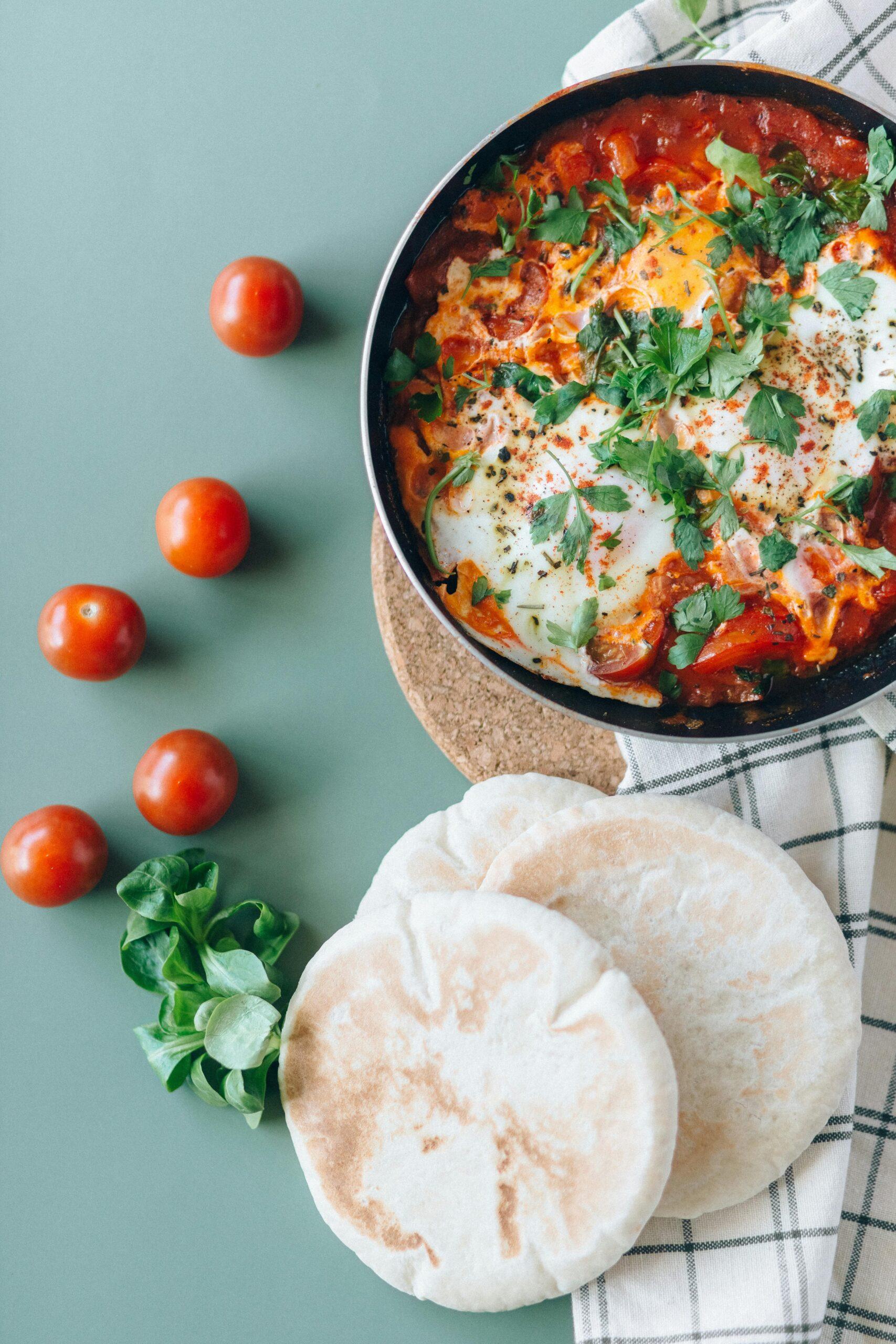Shakshuka, a breakfast staple that originated in North Africa and the Middle East, has become popular around the world. Derived from the Arabic word, “shakshuka,” which means mixture, this dish is a delicious blend of eggs, vegetables, and spices.
While people typically serve shakshuka in the morning for breakfast, you can really enjoy it any time of day. This dish brings together different flavors and cultures, and pairs well with pita bread, Israeli salad, and dips like hummus or tahini.
What’s the best part about shakshuka? You can easily customize it to fit your taste preferences, dietary needs, and cultural traditions. That’s why I’m excited to share my take on this flavorful, nutrient-dense meal, drawing inspiration from Kevin Curry of Fit Men Cook’s Mexican shakshuka recipe.
Shakshuka Nutrition Information
Check out the nutrition facts for key ingredients in this easy shakshuka recipe.
Olive oil
Olive oil contains monounsaturated fats, which can help lower LDL (bad) cholesterol and lower your risk of heart disease. It’s also rich in antioxidants that can help reduce inflammation and protect your body’s cells from damage.
Eggs
Eggs are a high-quality, easy to digest protein source, with 7 grams of protein each. They are also an excellent source of amino acids; minerals including phosphorus, calcium, choline, and potassium; and essential A, B, E, and K vitamins.
Bell peppers
Bell peppers are a low-calorie vegetable rich in vitamins A and C. These vitamins help strengthen your immune system and promote skin and eye health. Bell peppers also contain antioxidants and fiber that benefit brain and colon health.
Tomatoes
Tomatoes are rich in vitamin C, potassium, and folate. They also contain lycopene, an antioxidant shown to reduce the risk of heart disease by lowering blood pressure and LDL cholesterol.
Garlic
Garlic contains vitamins C and B6, and minerals like manganese and selenium. It’s a flavorful, heart-healthy addition to any dish because it helps lower blood pressure. Some studies also suggest that garlic has immune-boosting and anti-inflammatory properties that can help reduce inflammation in the body.
Onion
Onions are high in vitamins C and B6, and are a good source of folate, potassium, and antioxidants. Onions also contain compounds, fiber, and prebiotics that support heart and digestive health.
Cumin
Cumin is commonly used in Middle Eastern and Mexican cooking. This spice contains compounds that may increase digestive enzyme activity, potentially alleviating symptoms such as indigestion, bloating, and gas. It also contains compounds and antioxidants that may help lower inflammation in the body, regulate blood sugar levels, and lower cholesterol.
Chili powder
Chili powder is made from dried chili peppers, cumin, garlic powder, and oregano. It contains capsaicin, which not only gives it its spicy flavor but also helps increase metabolism. As a result, capsaicin can help support weight loss and management. The capsaicin in chili powder can also help lower your blood pressure and improve blood circulation, reducing the risk of blood clots, heart attack, and stroke.
Paprika
Paprika is a spice that’s rich in antioxidants, which help reduce your risk of chronic diseases like cancer, heart disease, and diabetes. The antioxidants in paprika can also support eye health, immune function, blood circulation, and digestion.
Coriander
Coriander is rich in vitamins C, K, and A, as well minerals like potassium, manganese, and folate. It supports digestive health, reduces inflammation, lowers blood pressure and cholesterol, and helps regulate blood sugar.
- 2 tablespoons olive oil
- 4 cloves of garlic finely chopped
- 1 medium onion chopped
- 1 red bell pepper diced
- 1 teaspoon coriander
- 1 teaspoon cumin
- 2 teaspoons paprika
- ¼ teaspoon chili powder
- 1 can diced tomatoes, crushed tomatoes, or roasted tomatoes
- 1 pinch sea salt and pepper
- 4-6 whole eggs
- 1 small bunch parsley or cilantro chopped
To start, heat the olive oil in a sauté pan on medium heat and add the chopped red pepper and onion.
Once the onions are translucent, add your spices and chopped garlic. You can also add red pepper flakes or cayenne pepper if you prefer a spicy tomato sauce.
Add the canned tomatoes and break them up using a large spoon. Season them with some salt and black pepper and bring the tomato sauce to a simmer.
Make small holes in the tomato mixture with a wooden spoon.
Crack the eggs into each hole and cook until the eggs are done to your liking. Shakshuka traditionally contains poached egg, so shorten your cook time if you like a runny yolk.
Garnish with fresh cilantro or fresh parsley, and enjoy!
- Serve with pita bread and hummus or tahini.
- If you’re watching your sodium intake, opt for no-salt-added, whole peeled tomatoes or use fresh whole peeled tomatoes.
- To make this recipe vegan, use tofu instead of eggs.
- If you’re not eating whole eggs, you can use egg whites.
- If you don’t like or eat tomatoes, you can make a green shakshuka using zucchini, spinach, and/or shaved brussel sprouts.
- Add toppings like chickpeas, spinach, feta cheese, olives, eggplant, or sliced avocado.
Want more recipes like this one sent straight to your inbox? Sign up for our newsletter.
Shakshuka Recipe FAQ
Explore frequently asked questions about this shakshuka recipe.
What type of bread is best with shakshuka?
People typically eat pita bread with shakshuka, but you can pick the type of toasted bread that meets your preferences and dietary needs.
What do you serve with shakshuka?
Shakshuka pairs well with pita bread, spreads like tahini and hummus, and Israeli salad.
What are the best toppings for shakshuka?
For extra flavor and nutrients, I recommend toppings such as chickpeas, spinach, crumbled feta cheese, olives, eggplant, or sliced avocado.
What country is shakshuka from?
Shakshuka is believed to come from Tunisia and Yemen. It’s commonly served in North Africa and the Middle East, and has become more popular in the United States.
What is shakshuka sauce made of?
Traditionally it’s made with diced tomatoes, garlic, and spices, but you can substitute tomatoes for vegetables like zucchini, spinach, and brussel sprouts if you don’t eat tomatoes.
What is the best type of pan to use for shakshuka?
A large, shallow stainless steel or cast iron skillet works best for making shakshuka.
What are the health benefits of shakshuka?
Shakshuka is a high-protein, nutrient-rich dish that can be part of a balanced eating pattern. The ingredients help support weight management, heart health, and gut health.
Work With a Culina Health Dietitian
Whether you’re looking for general healthy eating information or need help managing a health condition, our registered dietitians can support you. Through 1:1 virtual sessions, they work with you to create a personalized care plan to help you achieve your goals. Book a session today.






